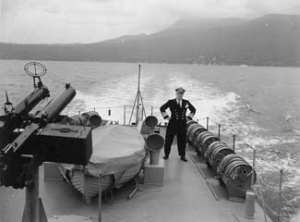Admiral Nelles, the son of the late Brigadier-General Charles M. Nelles, CMG (Companion of the Order of St. Michael and St. George), one of Canada’s most distinguished soldiers, was born at Brantford, Ontario on January 7th, 1892.
He enlisted as a Cadet in the Fishery Protection Service in 1909, the second of the first seven junior officers to start training for the anticipated Canadian Navy. In 1910, when the Canadian navy was established, six of these seven cadets passed into HMCS NIOBE as Midshipmen, Royal Canadian Navy (RCN), with Percy Nelles as senior Midshipman. (The cruisers HMCS NIOBE and HMCS RAINBOW were the first two ships of Canada’s navy. NIOBE was assigned to Canada’s east coast and RAINBOW to the west coast).
From 1911 to 1917 he served in ships and establishments of the Royal Navy (RN), then returned to Canada to become Flag Lieutenant to the late Admiral Sir Charles Kingsmill, RN, and then Chief of Staff of the RCN.
In 1920, Admiral Nelles went to the United Kingdom for a course at the Royal Naval College. Promoted to Lieutenant-Commander in 1922, he served for the next two years in ships and establishments of the Royal Navy and completed the war staff course at the RN College. He returned to Canada In August 1925 and in December of that year was promoted to Commander and appointed Senior Naval Officer, Esquimalt.

Admiral Nelles, photographed at sea in the early 1940s. Photo Catalogue No. VRP993.59.20, museum collection.
Back in the United Kingdom in 1929, Admiral Nelles served in various appointments until March of the following year, when he took command of the cruiser HMS DRAGON, becoming the first RCN officer to command a capital ship. He received the acting rank of Captain while in this appointment.
On his return to Canada in 1931, he reverted to Commander but in 1933, while in command of HMCS STADACONA, Admiral Nelles became the first Canadian to achieve the confirmed rank of Captain in the RCN. The next year he was promoted to Commodore and appointed Chief of the Naval Staff.
His promotion to Rear Admiral came in 1938. In the same year the naval appropriation, though still extremely modest, was increased to a figure three times that of 1934; two more destroyers were acquired from Great Britain and four minesweepers, built in Canadian shipyards, were commissioned.
In the summer of 1939, the Canadian Navy consisted of six destroyers, five minesweepers and a handful of auxiliaries, and had a total strength, permanent and reserve, of 3,604. A tiny navy, by any comparison, it was to grow, in remarkably short time, to a size beyond all recognition.
That this was accomplished was due largely to the foresight of Admiral Nelles. In spite of apathy without the service and frustration within, he never lost sight, in the pre-war years, of what he believed to be the Canadian Navy’s destiny. When war came, the plans he had carefully laid and nurtured were transformed into reality.
In January 1944, with the change of operational emphasis, Admiral Nelles moved overseas to assume the leadership of the RCN in the coming invasion of Europe.
A year later, with the RCN’s share in invasion operations successfully completed, Admiral Nelles retired, closing out a naval career that spanned more than 36 years. Promoted to Vice-Admiral in 1941, he was promoted to full Admiral on his retirement, in recognition of his service.
In His Majesty’s New Year’s Honours List of 1943, Admiral Nelles was appointed a Companion of the Most Honourable Order of the Bath. In 1946, the United States honoured him with membership in the Legion of Merit, degree of Commander.
Admiral Nelles retired to Victoria to live. He became seriously ill toward the end of May 1951 and died two weeks later. Surviving him were his wife, the former Helen Schuyler Allen, and two sons, Charles M. Nelles of Victoria and Midshipman William A. Nelles.


 CFB Esquimalt Naval and Military Museum
CFB Esquimalt Naval and Military Museum CFB Esquimalt Naval and Military Museum
CFB Esquimalt Naval and Military Museum CFB Esquimalt Naval and Military Museum
CFB Esquimalt Naval and Military Museum